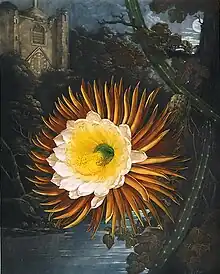.jpg.webp)
Abraham Pether (1756 – 13 April 1812) was an English landscape painter, recognised for his skill in depicting moonlit scenes. He was also a talented musician, inventor, mathematician and philosopher.[1]
Life and work

Abraham was born in Chichester in Sussex in 1756,[1][2] and was a cousin of notable engraver William Pether.[1] In childhood he showed a great talent for music, and at the age of nine played the organ in one of the Chichester churches.[1]
Adopting art as his profession, he became a pupil of George Smith,[1][2] whom he greatly surpassed. He painted river and mountain scenery, with classical buildings, in a pleasing though artificial style but his reputation rests on his moonlight subjects, which attracted much admiration, and earned for him the sobriquet of "Moonlight" Pether.[1] He was partial to the combination of moonlight and firelight, as in such subjects as Eruption of Vesuvius, Ship on Fire in a Gale at Night, An Iron foundry by Moonlight etc., which he painted with fine feeling and harmony of colour.[1][2]

Pether was a major exhibitor with both the Free Society of Artists and the Incorporated Society of Artists from 1773 to 1791, and at the Royal Academy from 1784 to 1811.[1][2] He was a member of the Incorporated Society of Artists.[2] His "Harvest Moon", which was at the Academy in 1795, was highly praised at the time.[1][2] He had an extensive knowledge of scientific subjects, and in his moonlight pictures the astronomical conditions are always correctly observed.[1]
Pether was also a clever inventor, constructing telescopes and microscopes for his own use, and lectured on electricity using instruments of his own making.[1][2] He also invented his own type of pencil.[3]

Although his art was popular, Pether was never able to do more than supply the daily wants of his large family, and when attacked by a lingering disease, which incapacitated him for work and eventually caused his death, he was reduced to great poverty.[1] He died at Southampton on 13 April 1812, leaving a widow, Elizabeth, and nine children quite destitute;[1][2] and the fact that they were unable to obtain any assistance from the Artists' Benevolent Fund was made the occasion of a fierce attack upon the management of that society.[1] Elizabeth Pether later went into business with a partner Thomas Thornton as "Pether & Co.", selling black lead and chalk pencils. An advertisement in The Times in 1816 stated of the instruments: "the leads being freed by a chymical process from all impurities, and scratching particles".[3]
Abraham Pether and his sons Sebastian (1793–1844) and Henry Pether (1800-1880), specialised in moonlit scenes.[4][5] It is thought that Abraham had a brother called Thomas Pether (they are recorded as sharing a residence); the latter was a wax modeller who exhibited portraits in wax with the Free Society of Artists from 1772 to 1781.[1]
See also
References
- 1 2 3 4 5 6 7 8 9 10 11 12 13 14 15
 One or more of the preceding sentences incorporates text from a publication now in the public domain: Lee, Sidney, ed. (1896). "Pether, Abraham". Dictionary of National Biography. Vol. 45. London: Smith, Elder & Co. p. 80.
One or more of the preceding sentences incorporates text from a publication now in the public domain: Lee, Sidney, ed. (1896). "Pether, Abraham". Dictionary of National Biography. Vol. 45. London: Smith, Elder & Co. p. 80. - 1 2 3 4 5 6 7 8 Redgrave, Samuel (1878). A dictionary of artists of the English School : painters, sculptors, architects, engravers and ornamentists, with notices of their lives and work. London: Bell. p. 328.
- 1 2 "British artists' suppliers, 1650-1950 - P: Penther & Co". National Portrait Gallery. Retrieved 15 November 2022.
- ↑ Trinity House. Trinity House: The Collection. New York, London: Trinity House. p. 68.
- ↑ Maas, Jeremy (1988). Victorian painters. London : Barrie & Jenkins. p. 50. ISBN 978-0-7126-2121-2.
External links
- Paintings by Abraham Pether (Government Art Collection)
- A moonlit river landscape with cattle on a track (Oil on canvas, 1793 – Christie's)
- Moonlight Scene (Hull Museum Collections)